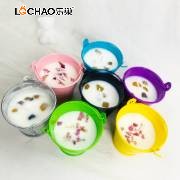Scented candles come in many materials, but it's generally not recommended to buy paraffin wax candles. This is mainly due to a combination of considerations regarding health, environmental protection,
and user experience.
Simply put, paraffin wax candles are like "fast food" in the scented candle world—cheap and readily available, but in the long run, they may do more harm than good to you and your family.
Here are a few detailed reasons:
1. Health Risks: The potential release of harmful substances is the most critical and worrying issue.
• Raw Material Source: Paraffin wax is a byproduct of petroleum refining and belongs to the mineral wax category. This means it originates from fossil fuels.
• Combustion Products: When paraffin wax burns incompletely, it may release some harmful chemicals, the most concerning being benzene and toluene. These are volatile organic compounds (VOCs),
known carcinogens and toxic substances.
• Benzene: Classified as a Group 1 carcinogen by the World Health Organization and linked to leukemia.
• Toluene: Affects the nervous system and may cause headaches, nausea, and other symptoms.
• Impact on Indoor Air Quality: Burning paraffin candles in enclosed spaces (such as bedrooms and studies) allows trace amounts of harmful substances to accumulate in the air. Long-term use may pose
potential risks to respiratory health, especially for children, the elderly, and those with a history of asthma or allergies.
It's important to note that the amount of harmful substances released by paraffin candles is still debated in the scientific community. However, out of caution, especially when safer alternatives are available,
most people choose to avoid this potential risk.
2. Adding Inferior Fragrances and Lead Wicks
To reduce costs, cheap paraffin candles often use inferior synthetic fragrances and lead wicks, further exacerbating health problems.
• Synthetic Fragrances: These may contain phthalates and other plasticizers, which can interfere with the endocrine system. During combustion, these chemical fragrances break down into more complex compounds that are inhaled.
• Lead Wicks:To make the wick stand longer, some older or inferior candles use lead wicks. Burning paraffin candles directly release lead particles into the air, causing serious lead pollution and affecting children's intellectual
development. Although banned in many countries, they may still be present in some products from unofficial channels.
3. Poor Burning Experience
Compared to natural waxes, paraffin candles often offer a less pleasant user experience.
• Black Smoke and Dust: Paraffin candles are more prone to producing black smoke, especially at the moment of lighting or extinguishing, or when the wick is too long. This black smoke can blacken ceilings, walls, and household items,
making it difficult to clean.
• Impure Fragrance: Because paraffin itself has a slight petroleum odor, it may interfere with or contaminate the pure fragrance of essential oils, resulting in a "cheap" or chemical smell.
• Uneven Burning: Lower-quality paraffin candles are prone to uneven burning and tunneling, leading to waste.
What are Safer and Higher-Quality Options?
It is recommended to choose scented candles made from natural plant waxes, which are currently recognized as a healthier and more environmentally friendly alternative.
Recommended Natural Wax Materials:
1. Soybean Wax
* Advantages: Derived from renewable resources (soybeans), burns cleanly with little smoke. Lower burning temperature prevents the wax from getting too hot, allowing for a slower, more lasting fragrance
release and a longer lifespan. Easy to clean (can be washed with hot water and soap).
* Disadvantages: Softer texture, usually needs to be mixed with other waxes or stored in a container.
2. Coconut Wax
* Advantages: Considered one of the highest-grade waxes. Burns very cleanly, almost smokeless, with excellent fragrance retention. Smooth and delicate texture.
* Disadvantages: Usually the most expensive.
3. Beeswax
* Advantages: One of the oldest waxes, naturally possessing a sweet honey aroma. Releases negative ions when burning, helping to purify the air and eliminate odors and dust. Long burning time with almost no smoke.
* Disadvantages: Its unique natural aroma may clash with added fragrances; also relatively expensive.
4. Plant-Based Wax Blends
Many high-end brands use blends of soy wax, coconut wax, carnauba wax, etc., to balance hardness, burning time, and fragrance diffusion.
In conclusion, while paraffin wax scented candles are inexpensive, considering their potential health risks and less pleasant burning experience, investing in a high-quality scented candle made from natural
waxes is undoubtedly a wiser and more reassuring choice for the health and quality of life of you and your family.





